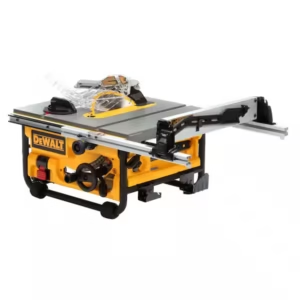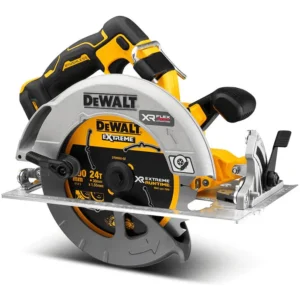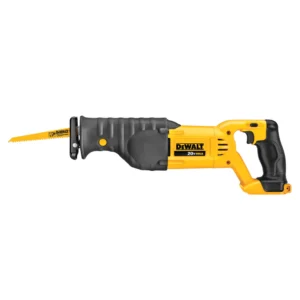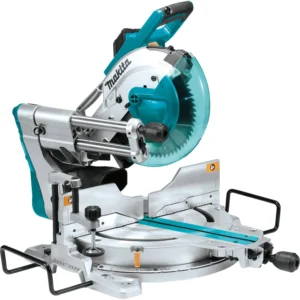Why DeWalt Saws?
DeWalt has been a household name in professional and DIY power tools for decades. Known for rugged build quality, high-performance motors, and a wide ecosystem of batteries and accessories, DeWalt saws are a go-to for carpenters, contractors, woodworkers, and serious hobbyists. This guide covers everything you need to know about DeWalt power tool saws — the types available, how to choose the right saw for the job, key features to look for, top models by category, maintenance tips, safety, and the most frequently asked questions.
Whether you’re shopping for a first saw or expanding your kit, this article is organized to help you choose confidently and use your saws safely and efficiently.
1. Types of DeWalt Power Tool Saws (Overview)
DeWalt makes a wide range of saws designed for different tasks. Here are the main categories:
1.1 Circular Saws
Versatile, handheld saws used for ripping and crosscutting sheet goods, dimensional lumber, and framing material. Available in corded and cordless versions with multiple blade sizes (common: 6-1/2″, 7-1/4″, 8-1/4″).
1.2 Miter Saws (Chop Saws / Compound & Sliding Compound)
Designed for precise crosscuts, bevels, and compound angles — essential for trim work, crown molding, framing, and finish carpentry. DeWalt offers single-bevel, dual-bevel, and sliding compound miter saws in various blade diameters (10″, 12″).
1.3 Table Saws
Stationary saws for accurate ripping and repeatable cuts. DeWalt’s portable table saws are popular on job sites due to a balance of accuracy, power, and portability.
1.4 Track Saws (Plunge Saws)
Built for straight, splinter-free long cuts in sheet goods (plywood, MDF), track saws offer a guided plunge cut that rivals a circular saw on a guide but with superior control.
1.5 Jigsaws (Scroll Saws: handheld)
Used for curved cuts and intricate work. They excel when cutting patterns, shapes, or plunge cuts in thinner stock.
1.6 Reciprocating Saws (Sawzall-style)
Ideal for demolition, pruning, and rough cutting: fast, aggressive cutting of wood, metal, and composite materials in cramped spaces.
1.7 Specialty & Stationary Saws (including radial arm / dado blades)
DeWalt also makes specialty saws and accessories (dado sets for table saws or stationary saw packages) that expand the functionality for production shops.
4. Top DeWalt Saw Models by Category (What Professionals Often Choose)
Below are the typical models professionals gravitate toward. Note: model numbers and lineup evolve; use this as a category-level guide.
4.1 Best Circular Saws (job site & framing)
-
Compact 7-1/4″ circular saws: Balanced power-to-weight for framing and general cutting.
-
Cordless 20V MAX circular saws: Popular for portability; pair with high-capacity battery for long runtime.
Why they’re chosen: cut speed, bevel capability, magnesium shoe (durability), and blade-change systems that minimize downtime.
4.2 Best Miter Saws (finish & framing)
-
12″ sliding compound miter saw: Versatile for crown molding and wide trim boards.
-
Dual-bevel sliding compound models: Save time on bevel cuts without flipping the workpiece.
Why they’re chosen: precision fences, detent plate accuracy, positive stops, and smooth sliding rails.
4.3 Best Table Saws (portable)
-
Jobsite table saws: Offer enough rip capacity for sheet goods; foldable stands improve job-site mobility.
-
Compact contractor saws: Balance portability and cutting accuracy.
Why they’re chosen: rack-and-pinion fences, easy blade changes, integrated stands.
4.4 Best Track Saws (plunge & sheet goods)
-
Plunge track saw combos: Deliver straight, splinter-free cuts in large plywood sheets better than freehand circular saws.
-
Often used for on-site cabinet cuts and precise joinery prep.
Why they’re chosen: straight cuts, plunge capability, and excellent dust control when paired with a shop vac.
4.5 Best Jigsaws (curved cuts)
-
Orbital jigsaws with variable speed: Adaptable to a range of materials; efficient in curved cuts and plunge cutting.
Why they’re chosen: stroke control, clean cuts with right blade, and comfortable handles.
4.6 Best Reciprocating Saws (demolition)
-
High-stroke, variable speed recip saws: The workhorses for demo and pruning — quick blade change and long stroke length for faster cuts.
Why they’re chosen: aggressive cutting, long battery life on cordless variants, and durable construction.
5. Buying Guide — How to Choose the Right DeWalt Saw
Here’s a step-by-step approach to match a saw to your needs.
5.1 Step 1: Identify Your Primary Use
-
Finish carpentry (trim, crown): Miter saw
-
Framing and roofing: Circular saw (or framing-specific circular saw)
-
Cabinetmaking and kitchen installs: Track saw + table saw
-
Demo and site cleanup: Reciprocating saw
-
General-purpose shop: Table saw + jigsaw for detail work
5.2 Step 2: Choose Power Source
-
If you need mobility and portability: Cordless (20V MAX/FlexVolt).
-
For continuous heavy work and stationary setups: Corded.
5.3 Step 3: Think About Blade Size and Capacity
-
Bigger blades = deeper cuts. Choose 12″ for larger trim and deep stock; 7-1/4″ is standard for circular saws.
5.4 Step 4: Look for Important Features
-
Electric brake (stops blade quick)
-
Dust extraction port
-
Bevel and miter scales (for precision)
-
Soft-start (for safer, smoother motor spin-up)
-
Tool-free blade change (reduces downtime)
5.5 Step 5: Consider Ergonomics & Weight
A heavy saw can cause fatigue. For overhead or extended handheld cuts, prioritize a lighter model with a good grip.
5.6 Step 6: Budget & Ecosystem
Factor in batteries, chargers, and blades. If you already own DeWalt batteries, buying another DeWalt cordless tool can be economical.
6. Blades & Accessories — What to Buy Alongside Your Saw
6.1 Selecting the Right Blade
-
Rip blades: Low tooth count (24–30), designed for fast ripping.
-
Crosscut blades: Higher tooth count (60–80) for clean crosscuts.
-
Combination blades: Mid-range teeth (40–50) for versatility.
-
Plywood/laminate blades: Thin kerf, high tooth count to reduce tear-out.
-
Metal cutting blades: Specially designed for abrasive or carbide teeth.
6.2 Dust Collection & Health
-
Use DeWalt dust bags, dust shrouds, and a compatible shop vacuum for best results.
-
For prolonged woodworking, consider a HEPA-rated respirator and dust extraction on the saw.
6.3 Stands, Fences & Guides
-
Portable table saw stands, miter saw stands, and track extensions increase productivity and accuracy.
-
Rip fences with rack-and-pinion drive offer smooth adjustments.
6.4 Batteries & Chargers (for cordless)
-
Higher Ah (amp-hour) batteries deliver longer runtime.
-
Fast chargers reduce downtime; having a pair of batteries is smart for continuous work.
6.5 Clamps & Work Supports
-
Use sacrificial backers, featherboards, and clamps for safety and accuracy when cutting small or delicate pieces.
Maintenance & Care — Extend the Life of Your DeWalt Saw
7.1 Daily Care
-
Clean sawdust and debris from vents, shoe, and moving parts.
-
Inspect blade for nicks and replace if damaged.
-
Make sure blade bolts are tight.
7.2 Regular Maintenance (Weekly/Monthly)
-
Check alignment of fences and miter gauges.
-
Lubricate sliding rails and pivot points with light machine oil.
-
Inspect cord and plug on corded models; check battery contacts on cordless units.
7.3 Blade Sharpening & Replacement
-
Replace or professionally sharpen blades as they dull — a sharp blade is safer and produces cleaner cuts.
-
Use the correct blade for the material to avoid overheating and damage.
7.4 Storage
-
Store in a dry place; for cordless tools, remove batteries when not in use to prevent battery degradation.
-
Keep tools in cases or on racks to avoid accidental damage.
Common Problems & Troubleshooting
8.1 Motor Won’t Start
-
Corded: check outlet, power cord, and switch.
-
Cordless: check battery charge and seating; confirm battery is charged and compatible.
8.2 Burning Smell During Cuts
-
Blade dull or wrong blade type. Stop and inspect. Use the right blade and feed at appropriate speed.
8.3 Blade Wobble or Vibration
-
Check arbor nut tightness, blade for warping, and arbor for damage. Replace blade if warped.
8.4 Poor Cut Accuracy
-
Check fence alignment and miter gauge calibration; confirm blade is square to the table/plate.
8.5 Short Battery Runtime
-
Battery age, extreme temperatures, heavy load, or motor inefficiency. Consider higher Ah battery or multiple batteries.
9. Safety Best Practices
Saws are powerful tools — safety is non-negotiable.
9.1 Personal Protective Equipment (PPE)
-
Eye protection (safety glasses or face shield)
-
Hearing protection (ear muffs or plugs)
-
Dust mask or respirator for long dust exposure
-
Gloves when handling raw material (not recommended while operating rotating blades due to entanglement risk)
9.2 On the Jobsite / Workshop
-
Use push sticks and featherboards on table saws.
-
Never remove guards; ensure anti-kickback pawls are in place.
-
Keep bystanders away, especially kids and pets.
-
Disconnect power (unplug or remove battery) before changing blades or performing maintenance.
9.3 Kickback Prevention
-
Use riving knives and splitters when possible.
-
Maintain sharp blades and proper fence alignment.
-
Feed material at steady speed; avoid freehand rip cuts on tables without support.
9.4 Safe Material Handling
-
Secure longer boards with supports to prevent binding or lifting.
-
Inspect material for nails or screws before cutting.
10. Use Cases & Project Examples
10.1 Framing a Wall
-
Primary tools: 7-1/4″ circular saw for cutting studs, reciprocating saw for demo.
-
Tips: Use a chalk line for long straight cuts; a track saw is overkill here.
10.2 Building Cabinets
-
Primary tools: Table saw for ripping, track saw/plunge saw for sheet goods, miter saw for face frames, jigsaw for cutouts.
-
Tips: Use high-tooth-count blades for smooth edges on visible surfaces.
10.3 Trim & Finish Work
-
Primary tools: Compound miter saw for accurate angles; brad nailer (not a saw) for installation.
-
Tips: Use dual-bevel sliding miter saw to save time on bevel cuts.
10.4 Demolition & Remodeling
-
Primary tools: Reciprocating saw for cutting old framing and nails; circular saw for controlled cuts.
-
Tips: Keep multiple blades for metal and wood to prevent damage.
11. Comparison: DeWalt vs Other Major Brands (What Makes DeWalt Stand Out)
While many brands produce high-quality saws, DeWalt often gets chosen for:
-
Battery ecosystem: Large lineup of compatible batteries and chargers.
-
Ruggedness: Jobsite-oriented designs built to withstand harsh use.
-
Service & parts availability: Strong aftermarket parts and service network.
-
Feature set: Thoughtful user-focused features (blade changes, dust ports, fences).
When comparing, prioritize ergonomics, warranty, and whether the brand’s ecosystem matches your existing tools.
12. Environmental & Health Considerations
-
Wood dust is a respiratory irritant and can contain toxins (pressure-treated wood, MDF). Use proper dust collection and PPE.
-
Battery recycling: follow local regulations for battery disposal or recycling programs.
-
Energy efficiency: cordless brushless motors consume less power per cut and can be more energy efficient overall.
13. Budgeting — How Much Should You Spend?
-
Hobbyist DIY: Expect to spend modestly for a single circular or jigsaw (~lower-end corded or cordless combos).
-
Serious DIY / Small Contractor: Mid-range miter saw, table saw, track saw — invest in batteries, one or two high-capacity chargers.
-
Professional Contractors: High-end cordless models, multiple batteries, jobsite table/miter saw combos, and robust accessories.
Factor in blades, batteries, chargers, stands, and dust management when building your budget.
14. Frequently Asked Questions (SEO-Friendly FAQ Section)
Q: Are DeWalt saws good for professionals?
A: Yes. DeWalt is widely used by professionals for its durability, performance, and comprehensive battery ecosystem.
Q: What battery platform does DeWalt use?
A: DeWalt’s primary cordless platforms are 20V MAX and FlexVolt. FlexVolt offers higher voltage when more power is needed and compatibility with 20V tools.
Q: Can I use DeWalt blades with other brand saws?
A: Generally yes, as long as the blade diameter and arbor size match. Always confirm compatibility before use.
Q: How often should I replace a saw blade?
A: Depends on usage and material. With heavy daily use, blades may need replacement monthly; for occasional DIY, once a year could suffice. Replace when you notice burning, chipping, or rough cuts.
Q: Are DeWalt saws good for cutting metal?
A: Some DeWalt saws can cut metal with the right blade (e.g., reciprocating saws or circular saws with metal-cutting blades). For heavy metal cutting, use tools and blades designed specifically for metal.
Q: What safety features should I look for in a table saw?
A: Riving knife, blade guard, anti-kickback pawls, and a good fence system. Consider a SawStop-style safety system if available in your region (note: DeWalt historically hasn’t built SawStop technology into their typical jobsite saws).
Q: How do I reduce tear-out when cutting plywood?
A: Use a track saw or a zero-clearance insert on a table saw. Backing up the cut with sacrificial board or using a fine-tooth blade also helps.
15. Practical Tips & Pro Tricks
-
Always let the blade reach full speed before starting the cut.
-
When cutting long stock on a table saw, support the outfeed side with stands to prevent binding.
-
Use push blocks for small rip cuts to keep hands away from the blade.
-
Match blade tooth geometry to the cut you need — it’s worth the small extra cost.
-
Keep at least one spare battery charged and ready to reduce downtime on cordless tools.
16. Warranty & Support
DeWalt typically offers warranties (tool-dependent) and often a limited warranty on power tools. Check warranty specifics with your dealer at purchase; depending on your country/region, registered tools can come with extended service benefits. Keep receipts and register tools when available.
17. Final Verdict — Is a DeWalt Saw Right for You?
If you prioritize durability, a broad ecosystem of compatible tools and batteries, and jobsite reliability, DeWalt is a strong choice. Their saw lineup covers nearly every woodworking and construction need, from rough framing to delicate finish work. Match the saw model to your specific tasks, invest in quality blades and dust management, and you’ll have a toolkit that performs for years.
18. Suggested Content & On-Page SEO Elements (for web publishing)
-
Primary keywords: DeWalt power tool saws, DeWalt saw, DeWalt circular saw, DeWalt miter saw, DeWalt table saw
-
Secondary keywords: DeWalt cordless saw, DeWalt track saw, best DeWalt saw, DeWalt blade guide
-
Suggested H1: DeWalt Power Tool Saws — Complete Guide
-
Suggested H2s: (use the section headings above)
-
Schema: Implement FAQ schema for the FAQ section; include product schema if listing specific models.
-
Image alt text examples: “DeWalt 12-inch sliding miter saw on stand”, “DeWalt cordless circular saw cutting plywood on site”
-
Internal links: Link to product category pages (e.g., /saws/dewalt-miter), safety pages, and blade-buying guides.
-
External links: Link to DeWalt official product pages and trusted retailers for model specs and purchases (if publishing on a site).
DeWalt Saws
Showing all 4 results
-
DeWalt power tools, DeWalt Saws
dewalt 20V MAX Circular Saw
When it comes to cordless power tools, DEWALT is a name trusted by professionals and DIYers worldwide. Among their most popular tools is the DEWALT 20V MAX Circular Saw, a powerful and versatile cutting solution designed for convenience, portability, and performance. Whether you’re cutting plywood, framing lumber, or trim boards, this cordless circular saw delivers.
SKU: n/a -
DeWalt power tools, DeWalt Saws
Sliding Compound Miter Saw
A sliding compound miter saw is a must-have tool for any serious woodworker, carpenter, or DIY enthusiast. This versatile machine combines precision, power, and flexibility, making it ideal for everything from crown molding to framing lumber. In this guide, we’ll explore everything you need to know about sliding compound miter saws, including how they work, key features, best uses, top brands, safety tips, and maintenance guidelines.
SKU: n/a




